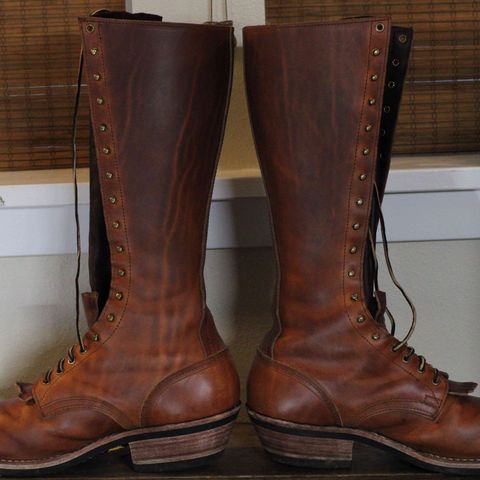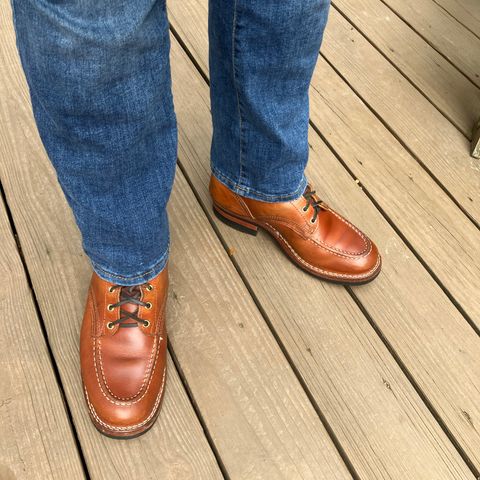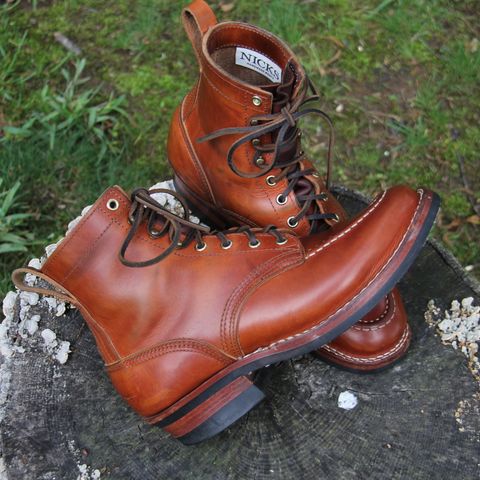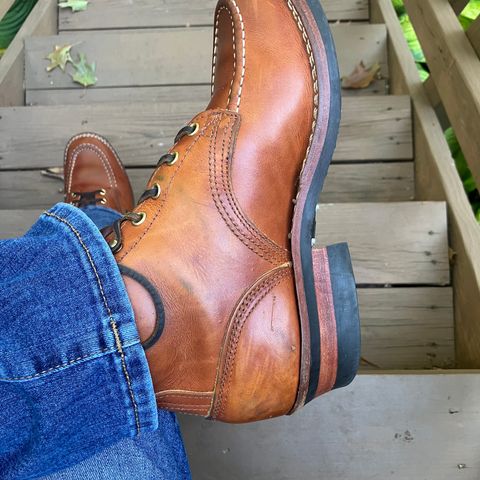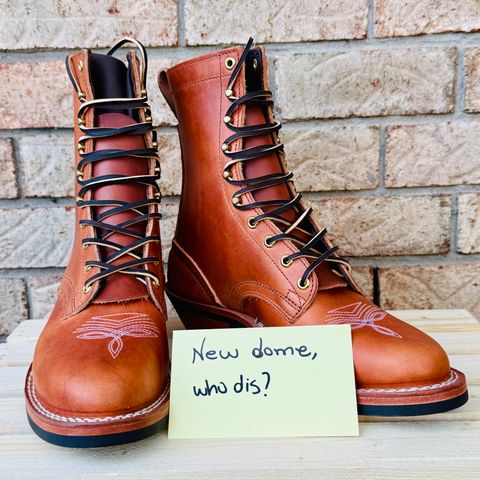About
Wickett & Craig Natural Double Stuffed is a vegetable-tanned leather that undergoes a double hot stuffing process with waxes, oils, and tallows. The leather is produced exclusively for Nicks Handmade Boots through a collaboration with Wickett & Craig, an American tannery founded in 1867. The natural finish starts light in color and develops a rich patina over time as the leather ages. At six ounces in thickness, Natural Double Stuffed is a Double Stuffed color variant that features the dramatic pull-up characteristics and improved durability associated with the double stuffing process.
About
Wickett & Craig Natural Double Stuffed is a vegetable-tanned leather that undergoes a double hot stuffing process with waxes, oils, and tallows. The leather is produced exclusively for Nicks Handmade Boots through a collaboration with Wickett & Craig, an American tannery founded in 1867. The natural finish starts light in color and develops a rich patina over time as the leather ages. At six ounces in thickness, Natural Double Stuffed is a Double Stuffed color variant that features the dramatic pull-up characteristics and improved durability associated with the double stuffing process.
Manufacturing process
The leather undergoes Wickett & Craig's traditional vegetable tanning process, which takes approximately six weeks from raw hide to finished leather. The tannery sources hides from North American cattle of European stock and tans them using natural tannins extracted from Mimosa and Quebracho tree bark. During this process, hides soak in tanning liquor for two weeks with continuous recirculation through 72 tanning vats.
After the initial vegetable tanning is complete, the leather receives its first hot stuffing treatment where waxes, oils, and tallows are applied. The defining characteristic of Double Stuffed leather is that it returns to the stuffing drums a second time at the end of the finishing process for an additional dose of conditioning agents. This double treatment saturates the leather with oils and waxes, creating improved stain resistance and pliability compared to single-stuffed leathers.
The hot stuffing process itself dates back hundreds of years and involves impregnating the hide with animal waxes and tallows. Unrefined fats and oils that are solid at room temperature are pounded into the skins through tumbling in heated barrels without the use of water or emulsifiers. This deep penetration ensures the leather maintains its soft, supple texture and creates the characteristic pull-up effect where lighter-hued lines and color variations appear when the leather is pulled, folded, or stretched.
Characteristics
The natural finish begins light in color without dyes or pigments applied to the vegetable-tanned base leather. When exposed to sunlight, the leather transitions through color stages, changing from natural to pink to reddish tones before eventually darkening to a rich caramel brown. The leather is split and shaved to a final thickness of six ounces during production, making it slightly lighter than typical seven to eight ounce work boot leathers while maintaining durability through the saturation of conditioning agents.
The pull-up effect created by the double stuffing process highlights the grain and character of the leather. As waxes and oils shift within the leather structure when stressed or flexed, color variations become visible on the surface. This characteristic is particularly pronounced in Natural Double Stuffed due to the absence of pigment, allowing the full range of the leather's movement to be displayed visually.
The heavy saturation with oils and waxes makes the leather essentially self-conditioning. Initially, excess wax may create a cloudy or hazy appearance on the surface, but this bloom can be buffed away or will wear off naturally through use. Over extended periods, oils and waxes from the leather's core are drawn to the surface, maintaining conditioning without regular application of products.
Patina development
Vegetable-tanned leather develops patina through interaction with environmental factors and handling. For Natural Double Stuffed, patination begins with sun exposure, which causes the undyed leather to darken progressively. Areas that receive consistent sunlight exposure transition through warmer tones more quickly than protected areas, creating natural variations in color across the leather's surface.
Handling contributes significantly to patina formation. Contact with skin oils, particularly in areas that are frequently grabbed or where hands rest, causes accelerated darkening. Places that experience regular rubbing develop deeper, richer tones compared to less-handled sections. The leather at pressure points and flex areas burnishes darker as the fibers compress and oils migrate to the surface through mechanical action.
The patination process is unique to each item due to differences in usage patterns and environmental exposure. No two pieces age identically, as the specific combination of sun exposure, handling frequency, oil transfer from hands, and contact with other materials like denim creates an individual character. The leather continues to evolve throughout its lifespan, becoming more beautiful as the years pass and the patina deepens.
Care and maintenance
Natural Double Stuffed requires minimal active maintenance due to its saturated conditioning from the manufacturing process. The recommended care routine consists of brushing the leather once or twice per week with a natural bristle brush to remove surface dirt and distribute oils evenly across the surface. For heavier soiling, wiping down with a damp cloth removes debris without requiring specialized cleaning products.
During the first month of ownership, avoiding water exposure allows the leather to fully cure and the surface waxes to set properly. After this initial period, the leather develops moderate water resistance from its oil and wax content, though it should not be considered waterproof. Leather balm can be applied to provide additional water protection if needed for specific use conditions.
Heat sources should be kept away from the leather, as high temperatures can draw out conditioning oils too quickly and potentially damage the leather structure. If conditioning becomes necessary beyond the leather's self-maintaining properties, products specifically formulated for vegetable-tanned leather are appropriate. However, the double stuffing process typically provides sufficient conditioning for many years of use without supplemental treatment.
References
"Vegetable Tanning". Wickett-Craig. Retrieved October 9, 2025.
"Traditional Harness". Wickett-Craig. Retrieved October 9, 2025.
"Wickett and Craig Double Stuffed - Natural". Nicks Boots. Retrieved October 9, 2025.
"What Is Vegetable Tanned Leather?". Galen Leather. Retrieved October 9, 2025.
"Materials". Corter Leather & Cloth. Retrieved October 9, 2025.
